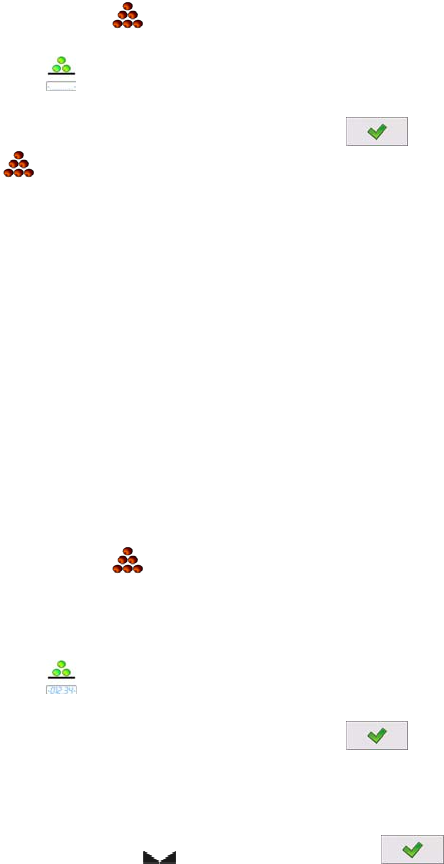User manual
Table Of Contents
- 1. INTENDED USE
- 2. PRECAUTIONARY MEASURES
- 3. WARRANTY CONDITIONS
- 4. UNPACKING AND MOUNTING
- 5. CONSTRUCTION
- 6. GETTING STARTED
- 7. KEYPAD OVERLAY
- 8. FUNCTIONS OF KEYS
- 9. PROGRAM STRUCTURE
- 10. INDICATING WINDOW
- 11. LOGGING ON
- 12. NAVIGATING WITHIN THE MENU
- 13. WEIGHING
- 14. SCALE PARAMETERS
- 15. COMMUNICATION
- 16. DEVICES
- 17. DISPLAY
- 18. INPUTS / OUTPUTS
- 19. AUTHORIZATION
- 20. OTHER PARAMETERS
- 21. CUSTOMER CALIBRATION
- 22. SPECIAL FUNCTIONS OF WORKING MODES
- 23. WORK MODE - WEIGHING
- 24. WORKING MODES – COUNTING PIECES
- 25. WORKING MODES – DEVIATIONS
- 26. WORKING MODES – COMPARATOR
- 27. DATABASES
- 28. COMMUNICATION PROTOCOL
- 28.1. General information
- 28.2. Inventory of RS commands
- 28.3. Respond message format
- 28.4. Command’s description
- 28.4.1. Zeroing
- 28.4.2. Tarring
- 28.4.3. Get tare value
- 28.4.4. Set tare value
- 28.4.5. Send the stable result in basic unit
- 28.4.6. Send the result immediately in basic unit
- 28.4.7. Send the stable result in current unit
- 28.4.8. Send the result immediately in current unit
- 28.4.9. Switch on continuous transmission in basic unit
- 28.4.10. Switch off continuous transmission in basic unit
- 28.4.11. Switch on continuous transmission in current unit
- 28.4.12. Switch off continuous transmission in current unit
- 28.4.13. Set lower threshold
- 28.4.14. Set upper threshold
- 28.4.15. Read lower threshold
- 28.4.16. Read upper threshold
- 28.4.17. Send all implemented commands
- 28.5. Manual printouts / automatic printouts
- 29. CONNECTING EXTERNAL DEVICES
- 30. DIAGRAMS OF CONNECTION CABLES
- 31. TECHNICAL PARAMETERS
- 32. ERROR MESSAGES
- 33. ADDITIONAL EQUIPMENT
- 34. APPENDIX A – Variables for printouts
- 35. APPENDIX B – Functions of programmable buttons
- 36. APPENDIX C – Label pattern
- 37. APPENDIX D - CITIZEN printer setting
- 38. APPENDIX E - ZEBRA printer setting
- 39. APPENDIX F - Communication with barcode scanners

24.2. Setting a reference unit by entering known piece mass
Procedure:
• Enter mode < Counting Pieces> according to ch. 24.1
of this manual,
• Press
(enter piece mass), then an editing field is displayed
<Reference Unit> with the screen keyboard,
• Enter a value and confirm it by pressing
, which causes starting
<
Counting Pieces> with automatic setting the reference unit.
Notice:
1. In case of entering a reference unit higher then the maximum weighing
range of the main scale the program will display a message box:
<Value too high>,
2. In case of entering the single piece mass lesser than 0.1 e of verified
scales and 1 d for non-verified scales, the program will display a
message box: <Value to small>,
24.3. Setting a reference unit by weighing a sample
Procedure:
• Enter mode < Counting Pieces> according to ch. 24.1
of this manual,
• If pieces are weighed in a container it needs to be put on the pan
and tarred,
• Press
(estimate piece mass), then the editing field is displayed
<Reference Quantity> together with the screen keyboard,
• Enter a value and confirm it by pressing
, then the following
message is displayed: <Put pieces: xx> (where xx – the value
entered before),
• Put the declared quantity of pieces on the pan and when the result
is stable (symbol
) confirm it by pressing .
72










